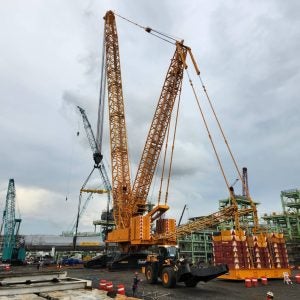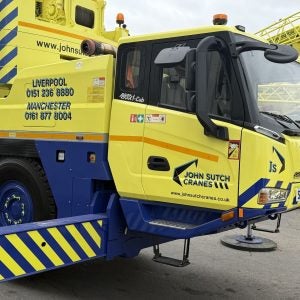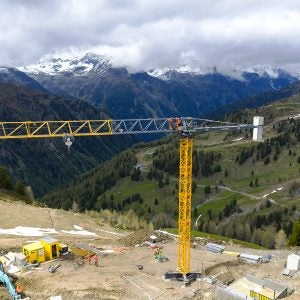Across the group, the Manitowoc Company reported sales of $1.1bn and operating earnings of $140.6m, up 19.6% and 19.2%, respectively, from the third quarter of 2007. A hedging loss of $198.4m, incurred as a result of the company’s purchase of Enodis and fluctuations in the value of sterling against the dollar, pushed the company into a loss for the quarter, of $26.1m.
The company explained that, ‘Manitowoc’s credit commitment required that 80% of the purchase price of Enodis be hedged by July 30, 2008. Given the significant reduction in the Great British Pound to US dollar exchange rate that has since occurred, the accounting treatment for the hedges put in place takes the form of a mark-to-market loss.
‘These hedges effectively capped the US dollar cost of Enodis at a more favourable exchange rate than was anticipated when Manitowoc announced its bid for Enodis. The accounting treatment of this hedge will lower the initial amount of goodwill booked for the acquisition by $198.4 million as of September 30, 2008.’
In the crane segment, sales totalled $991m, up 22% on Q3 2007. Operating earnings were up 24% year-on-year, to $139.0m. Year-on-year, the company’s crane order backlog rose 26%, to 3.3bn. However, the backlog slipped slightly from the second quarter of 2008, when it stood at $3.52bn. The backlog has risen consistently since the second quarter of 2005: in that quarter, crane orders slipped slightly to $530m, from $532m in the previous quarter.
The company said, “The sequential decline in Manitowoc’s crane backlog from the second quarter of 2008 reflected slowing demand for tower cranes in Europe, and a delay in opening the 2010 order book until material price forecasts and customer pricing arrangements can be finalised.”
CEO Glen Tellock said, “Demand for our high-capacity crawler and mobile telescopic cranes remains strong in markets where investment in large infrastructure and power generation projects continues. These markets include the Americas, the Middle East, India, and Asia. Demand has softened in China consistent with the anticipated ‘post-Olympic’ pause in construction projects. However, the availability and cost of financing in Europe, Russia, and Africa began impacting the demand for tower cranes during the quarter.
“Accordingly, we have taken prudent measures to maximise the performance of the crane segment during this period of economic turbulence. These measures include rebalancing the production schedules at our factories, eliminating temporary workers in certain European factories, internalising a variety of previously outsourced manufacturing activities, instituting numerous SG&A [selling, general and administrative] cost reductions and deferrals, and accelerating the ramp-up of lean manufacturing initiatives.”
In a conference call transcript provided by the website www.seekingalpha.com, CFO Carl Laurino is reported as telling analysts that “Contrasts between Manitowoc today versus the last downturn are worthy of note: global penetration of our products, spreading economic risk, consolidation within the crane industry, higher percentage of variable to fixed cost structure, percentage of manufacturing in low cost countries, notably China, India and Slovakia. Cost take-out initiatives achieved as part of our integration including five factory consolidations, one in food service and four in cranes.
“The development and introduction of dozens of innovative crane products are creating broad based demand across the global construction industry. Because of these differences, we expect to be able to generate total company operating margins at or near 10% in the next trough of the crane cycle, which we wouldn’t expect to see for at least a couple of years.”
In the same conference call, Eric Etchart, senior vice president and general manager of the cranes segment, gave an overview of global demand for cranes, saying, “We continue to see a lot of infrastructural projects in the Middle East, and this will remain a booming area. The slowdown we see is definitely in Europe, and [in] the last three months has been very obvious. It’s primarily the tower cranes business that is impacted. But now the French market has slowed down, following the UK and Southern Europe.
In Russia, there is probably a temporary blip, and again, it’s linked to credit tightening. We are of the opinion this is only temporary, because of the military action in Georgia, that you had some investor concerns about political risk. But the projects are there. Russia’s only full of reserves and currency, so we believe that Russia, after that slowdown, should pick up again.
“We have a slow down in China. That was expected after the Olympics, now it’s definitely a decelerating growth. China has again achieved 10% until mid 2008. So, we expect that slowdown but it’s certainly not going to be a recession in China. So, opportunities, gains will remain in China.
“Latin America continues to have strong demand, maybe because of the currency situation and the strengthening of the US dollar. We’ve seen that a little bit on towers but again the demand for mobile cranes and large RTs remain very, very strong. Finally, in the US, demand for large crawlers and large rough-terrain cranes is not slowing down.”






